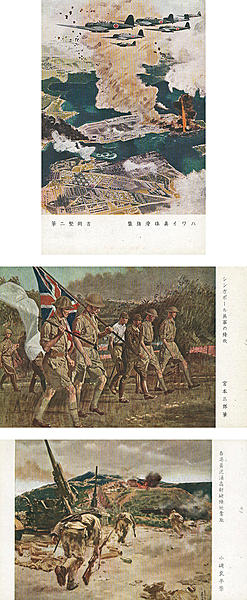World Stamps
Postcard images show battle scenes from Great East Asia War

Three picture postcards issued by Japan Dec. 8, 1943, show World War II battle scenes from Pearl Harbor, Hong Kong and Singapore.
A set of three picture postcards was issued by Japan Dec. 8, 1943. This set is found in collections not only of Japan, but also of Malaya and Hong Kong because of the scenes depicted on the cards.
A quick glance confirms that these postcards are military in nature. However, the inscriptions are in Japanese, and the exact meaning of these cards might not be immediately apparent to collectors.
The date of issue is a big clue.
One card depicts Japanese war planes dropping bombs over a seaside military base. The image shows Pearl Harbor, Hawaii, which was attacked by the Japanese Dec. 7, 1941 (Dec. 8 on the Japanese side of the International Dateline).
These three cards were issued to commemorate the second anniversary of what Japan termed the Great East Asia War, which the Japanese promoted as an unqualified success up to this point in 1943.
All of the cards are reproductions of paintings by official Japanese war artists.
The card depicting the bombing of Pearl Harbor is by Yoshioka Kenji.
The second card, showing a battle scene at Hong Kong, was painted by Koiso Yoshihira.
The last depicts the British surrender at Singapore, and was created by artist Miyamoto Saburo.
All of these men lived long lives and at least one of them, Miyamoto Saburo, became a celebrated artist, having a museum devoted to his art in Komatsu, Japan. He is famous for adopting Western style art to Japanese themes.
Most of us know the story of the attack on Pearl Harbor, but fewer know anything about the battles of Hong Kong or Singapore. Perhaps a brief description of each battle will help us understand how these cards fit into history.
Prior to the outbreak of war, Great Britain realized that its colonies in the Far East were vulnerable to Japanese attack. Britain sent several of its finest warships to Singapore and reinforced them with Australian troops, so that the British forces numbered about 100,000 men.
Singapore was nicknamed Fortress Singapore or the Gibraltar of the East and was considered impregnable. Rather than attack Singapore directly, the Japanese invaded Thailand to the north Dec. 8, 1941, and marched through the jungle to the back door of Singapore, their air forces having already sunk all the British capital ships.
By the time the Japanese reached Singapore, they were low on ammunition and down to about 30,000 men. But the British guns were all pointing out to sea to repel an invasion that never happened. The British fought until Feb. 15, 1942.
On the same day, Dec. 8, 1941, (Dec. 7 in Hawaii), the Japanese began their attack on Hong Kong.
As in Singapore, the British reinforced the Hong Kong garrison with inexperienced troops, from Canada and India.
The Japanese, on the other hand, had been fighting in China since 1938 and occupied the Chinese mainland surrounding Hong Kong.
The British had only five airplanes, and four of these were destroyed by the first Japanese air attack. Likewise, British naval forces were reduced to one destroyer, several gun boats and torpedo boats. All the other ships had been ordered to Singapore.
Nonetheless, British forces fought valiantly until Christmas Day, 1941.
So, Dec. 8, 1941, was a glorious day for Japan, and it was basking in the springtime of victory when these three picture postcards were issued. But after the Battle of Midway in the Pacific, the tide began to turn against Japan. All four of its aircraft carriers were destroyed in June 1942, and eventually the Japanese surrendered on Aug. 15, 1945.
But what happened to the original paintings that are the subject of these three cards?
After the war, the American government determined that they were war propaganda and confiscated them, along with many more similar works of art. Perhaps they are in a long forgotten warehouse somewhere in Washington, D.C.
MORE RELATED ARTICLES
Headlines
-
World Stamps
Oct 8, 2024, 12 PMPostcrossing meetup Oct. 9 at U.N. headquarters
-
Postal Updates
Oct 7, 2024, 5 PMUSPS plans to raise postal rates five times in next three years
-
US Stamps
Oct 7, 2024, 3 PMMcMurtrie dismissed as APS education director following Sept. 21 arrest
-
US Stamps
Oct 7, 2024, 12 PMVasiliauskas named president of Mystic Stamp Co.





